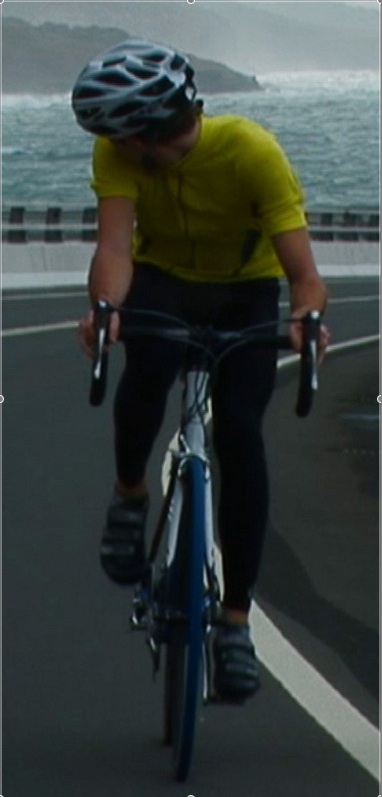Meredith Birrell bathes in the feedback of Hugh Marchant’s video self-portraiture…
Hugh Marchant is concerned with the medium of video and its power to create mood. Marchant disrupts our expectations of narrative and form. In his recent show at Gaffa’s SPIspace Hugh Marchant exhibiyted five works produced between 2008 and 2010, and included his self-portrait Hugh, which won the 2009 National Youth Self Portrait prize.
Marchant’s self-portrait was influenced by the work (I am Sitting in a Room) [1969] by sound artist Alvin Lucier. Lucier replayed a recording of his voice over again until his words were subsumed by the resonant frequencies of the room. As his speech becomes more distorted, we become increasingly aware of how Lucier’s own unique cadence is actually shaping the sound of the space around him. Similarly, Marchant also used a process of replaying and re-recording until the image of his face was degraded into a black and white pattern that he himself describes as “my identity, my fingerprint.”
The twisting, broken pathways are utterly determined by the shape and form of Marchant’s features, but they are pathways that only turn back on themselves and split and re-form as we watch, not leading us anywhere. The graphic tendency of the imagery counters the solidity of the head and suggests a sort of code or language that is completely personal and perhaps even un-readable by anyone expect the subject. It is certainly a ‘likeness’, that historical notion that attests to the success of a portrait by it’s similarity to the sitter, but Marchant goes deeper, exhausting the self-reflexivity of the self-portrait to the point where we see ‘under’ the skin of the subject, his inner fingerprint.
Still from Hugh, Hugh Marchant, Courtesy Gaffa Gallery
Despite its title, in Sydney to Gong we are also going nowhere, yet there is a feeling of urgency that makes us feel as if we should be getting somewhere, anywhere. The title of course suggests a beginning and end point, but we are denied seeing these, instead witnessing only a fragment of the cyclist’s indeterminate journey down the south coast of NSW. As we increasingly identify with the rider and engage in the rhythm of his pedaling, breathing and the tolling of some phantom bell, our expectation and anticipation builds. Yet this expectation is dashed and we end where we started, nowhere specific and still travelling. Like the self-portrait, Sydney to Gong finds its significance in the medium itself – in the sequence of frames, the close-up and mid-shot and the pace set by movement and sound. The medium is an end in itself.
After many promises, Barack Obama has still not made a visit to Australia and Marchant’s ABSENCE responds to this in a most simple but provocative way. To a soundtrack of Obama’s voice we see empty Canberra streets instead of the President’s motorcade and the House of Representatives devoid of human presence. The disembodied voice of Obama addresses no-one. Obama’s ‘speech’ is in fact a very clever editing together of various voice grabs of the President. It is put together so seamlessly that while Australia is never mentioned, the phrases are both general and specific enough to suggest he is indeed addressing the Australian parliament and people and when coupled with scenes of our National Capital, the fable is convincing. It is slightly unsettling how the well-intentioned but ultimately predictable platitudes that characterise such public addresses can be so easily transferred between contexts.
Things being emptied of their content, actively denying their meaning or turning back on themselves to frustrate meaning are ideas that do traverse all of these works. In Australia Square and Clay there is a similar tendency to go against form and use signs that point to something they are not instead of what they are. For example, the human and handmade notions we associate with the word ‘clay’ are contradicted by the fragile and alien space Marchant has created in this work. As we watch we are reminded that while clay is something that can be both supple and formless it can also be incredibly brittle and fine. The entrance of a human presence at the end is a shocking rupture in this environment and one that threatens to shatter its delicate framework.
Still from Sydney to Gong, Hugh Marchant, Courtesy Gaffa Gallery
Each work has its own contained mood and markedly different rhythm. Marchant explores a wide variety of techniques and formal concerns too, including colour, framing and the negative image. This was a very strong collection of work that wove together many different ideas while still retaining the primacy of the video medium. Marchant’s preference for understatement rather than a didactic tone renders the work that much more powerful, as we are invited to read our own meanings into the open-ended codes and find our own path through Marchant’s twists and turns of meaning.
Gaffa – SPIspace
Likeness – 5 Video Portraits by Hugh Marchant
Curated by J D Reforma, 24th Feb – 8th March



Pingback: Art Reviews « meredithbirrell